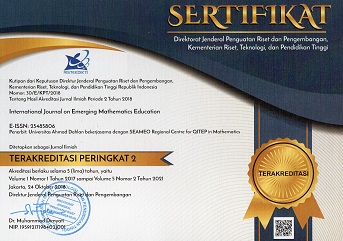Emergence of Contrast of Cognitive-Valuing Features of Mathematics Across Global Classrooms
Abstract
Processes and patterns in mathematics education are shaped into dynamic complex systems – referred to as a new structure because of the close interplay and networks of different social atoms. The study attempts to understand the interactions at the macro level using exploratory data analysis of secondary data from an international assessment organization in order to discover and fathom the interrelationship of the characteristics namely achievement in mathematics and valuing attitude towards math. Findings showed that global classroom displayed a decline of performance as the valuing to the discipline intensifies. Further analysis found out that presently, the nature of valuing is extrinsic which focuses in the practical use of the subject. With this, behavior in learning mathematics is not positive when geared towards usefulness; but it will dramatically change the achievement when approach is modified to being a desirable disciple.
Keywords
Full Text:
PDFReferences
Anderman, E. M., Eccles, J. S., Yoon, K. S., Roeser, R., Wigfield, A., & Blumenfeld, P. (2001). Learning to value mathematics and reading: Relations to mastery and performance-oriented instructional practices. Contemporary educational psychology, 26(1), 76-95. Retrieved from https://www.sciencedirect.com/science/article/pii/S0361476X99910433
Ashcraft, M. H., & Krause, J. A. (2007). Working memory, math performance, and math anxiety. Psychonomic bulletin & review, 14(2), 243-248. Retrieved from https://link.springer.com/article/10.3758/BF03194059
Beilock, S. L., & Willingham, D. T. (2014). Math Anxiety: Can Teachers Help Students Reduce It? Ask the Cognitive Scientist. American educator, 38(2), 28. Retrieved from https://eric.ed.gov/?id=EJ1043398
Burton, M. (2012). What Is Math? Exploring the Perception of Elementary Pre-Service Teachers. Issues in the Undergraduate Mathematics Preparation of School Teachers, 5. Retrieved from https://eric.ed.gov/?id=EJ970350
Cavanagh, S. (2008). Low Performers Found Unready to Take Algebra. Education Week, 28(5), 1-12. Retrieved from https://eric.ed.gov/?id=EJ812104
Davis, B., & Sumara, D. (2014). Complexity and education: Inquiries into learning, teaching, and research. Routledge.
Folke, C. (2006). Resilience: The emergence of a perspective for social–ecological systems analyses. Global environmental change, 16(3), 253-267. Retrieved from https://www.sciencedirect.com/science/article/abs/pii/S0959378006000379
Fuller, T., & Moran, P. (2001). Small enterprises as complex adaptive systems: a methodological question?. Entrepreneurship & regional development, 13(1), 47-63. Retrieved from https://rsa.tandfonline.com/doi/abs/10.1080/089856201750046801#.XIsbsegzbIV
Greenwood, J. (2011). Aesthetic learning, and learning through the aesthetic. In Key concepts in theatre/drama education (pp. 47-52). SensePublishers. Retrieved from https://link.springer.com/chapter/10.1007/978-94-6091-332-7_8
Holden, L. M. (2005). Complex adaptive systems: concept analysis. Journal of advanced nursing, 52(6), 651-657. Retrieved from https://onlinelibrary.wiley.com/doi/abs/10.1111/j.1365-2648.2005.03638.x
Johnson, M., & Kuennen, E. (2006). Basic math skills and performance in an introductory statistics course. Journal of Statistics Education, 14(2). Retrieved from https://www.tandfonline.com/doi/abs/10.1080/10691898.2006.11910581
Karimi, A., & Venkatesan, S. (2009). Mathematics anxiety, mathematics performance and academic hardiness in high school students. International Journal of Educational Sciences, 1(1), 33-37. Retrieved from https://www.tandfonline.com/doi/abs/10.1080/09751122.2009.11889973
Lansing, J. S. (2003). Complex adaptive systems. Annual review of anthropology, 32(1), 183-204. Retrieved from https://www.annualreviews.org/doi/abs/10.1146/annurev.anthro.32.061002.093440
Levin, S. (2003). Complex adaptive systems: exploring the known, the unknown and the unknowable. Bulletin of the American Mathematical Society, 40(1), 3-19. Retrieved from https://www.ams.org/journals/bull/2003-40-01/S0273-0979-02-00965-5/
Ma, X., & Xu, J. (2004). Determining the causal ordering between attitude toward mathematics and achievement in mathematics. American Journal of Education, 110(3), 256-280. Retrieved from https://www.journals.uchicago.edu/doi/abs/10.1086/383074
Newell, C. (2008). The class as a learning entity (complex adaptive system): An idea from complexity science and educational research. SFU Educational Review, 2. Retrieved from https://journals.lib.sfu.ca/index.php/sfuer/article/view/335
Reyna, V. F., & Brainerd, C. J. (2007). The importance of mathematics in health and human judgment: Numeracy, risk communication, and medical decision making. Learning and Individual Differences, 17(2), 147-159. Retrieved from https://www.sciencedirect.com/science/article/pii/S1041608007000416
Trends in International Mathematics and Science Study (2015). TIMSS 2015 and TIMSS Advanced 2015 International Results. Retrieved from http://timssandpirls.bc.edu/timss2015/international-results/wp-content/uploads/filebase/full%20pdfs/T15-International-Results-in-Mathematics.pdf
Uhrmacher, P. B. (2009). Toward a theory of aesthetic learning experiences. Curriculum Inquiry, 39(5), 613-636.Retrieved from https://www.tandfonline.com/doi/abs/10.1111/j.1467-873X.2009.00462.x
DOI: http://dx.doi.org/10.12928/ijeme.v4i1.15820
Refbacks
- There are currently no refbacks.
Copyright (c) 2020 Joshua Edson Gorme Ordiz

This work is licensed under a Creative Commons Attribution 4.0 International License.
International Journal on Emerging Mathematics Education
Kampus 2 Universitas Ahmad Dahlan
Jalan Pramuka No. 42, Pandeyan, Umbulharjo, Yogyakarta - 55161
Telp. (0274) 563515, ext. 4902; Fax. (0274) 564604
Email: ijeme@uad.ac.id
p-ISSN: 2549-4996 | e-ISSN: 2548-5806
This work is licensed under a Creative Commons Attribution 4.0 International License

